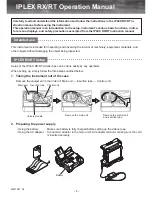
TX6000 Series Operation Manual Ver1.4
51
c)
Press ON to turn on the open correction function.
d)
Move the cursor to the SHORT zone, ON, OFF, MEAS OPEN and DCR
SHORT will be displayed in the soft key zone.
e)
Press ON to turn on the short correction function.
f)
Move the cursor to the LOAD zone, ON, OFF will be displayed in the soft key
zone.
g)
Press OFF to turn off the load correction function.
h)
Move the cursor to the Spot No. zone to select the correction point.
i)
Move the cursor to the FREQ zone, ON, OFF, MEAS OPEN, MEAS SHORT
and MEAS LOAD will be displayed in the soft key zone.
j)
Press ON to turn on the point-frequency correction function of FREQ.
k)
Press [5], at the bottom of the screen meanwhile the available units (Hz, kHz
and MHz) will be displayed in the soft key zone. Press kHz, the FREQ zone
will be changed as 5.00000kHz (be the same as that of test frequency).
l)
Keep the test fixture be in open status and press MEAS OPEN to execute
open correction.
m)
Insert the short plate (26010) to the test fixture.
n)
Press MEAS SHORT to execute short correction.
5.2
Correct connection of DUT
There are 4 pairs of test terminal: Hcur, Lcur, Hpot, Lpot and corresponding
shielding terminal of each terminal.
Each terminal contains shielding layer whose function is to reduce the
influence of the ground stray capacitance and the interference of the
electromagnetic field. In the process of testing, Hcur, Hpot and Lpot, Lcur should
be connected with DUT lead to form a complete 4-terminal measurement, thus
reducing the effect of the lead and the connection points on the test results
(especially the dissipation measurement). When testing low-ohm components,
Hpot, Lpot should be connected to the lead terminal so as to avoid the impedance
being added to the lead impedance and the connection principle is that the Hpot
and Lpot test should be the actual existed voltage on DUT.
In other words, before connecting to DUT, it is not recommended to connect
Hcur, Hpot with Lpot, Lcur, for doing this will increase test error.
If the connection point and the lead resistance R lead are far weaker than the
tested impedance (for example: R
lead
<Z
x
/1000, the accuracy error is required to
be less than 0.1%), before connecting to DUT, it is recommended to connect Hcur,
Hpot and Lpot, Lcur (Two terminal test).
In the test with high accuracy requirement, using Kelvin test fixture
(standard accessory) will gain better results than using test leads. When Kelvin
test lead is used under 10kHz, a better measurement result can be obtained.
However, when the frequency is higher than 10kHz, it cannot meet the
measurement demand. In high frequency, the change of the clearance between
test leads will directly change stray capacitance and inductance on test terminals
















































